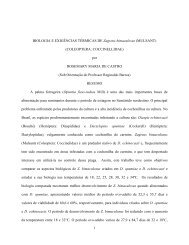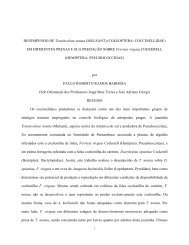Development of Spodoptera frugiperda on different hosts ... - UFRPE
Development of Spodoptera frugiperda on different hosts ... - UFRPE
Development of Spodoptera frugiperda on different hosts ... - UFRPE
Create successful ePaper yourself
Turn your PDF publications into a flip-book with our unique Google optimized e-Paper software.
238 Barros et al.<br />
was under investigati<strong>on</strong> in this study. Coordinated planting<br />
to create a host-free period between crop seas<strong>on</strong>s is recommended<br />
as a preventive practice to manage pests.<br />
However, in areas with irrigati<strong>on</strong> and a favorable climate,<br />
as is the case in the Brazilian Cerrado, corn, soybean, and<br />
cott<strong>on</strong> can be double cropped. The revenue obtained per<br />
area cultivated overcomes at first glimpse the risks<br />
imposed by pest infestati<strong>on</strong>, overcoming therefore the<br />
benefits <str<strong>on</strong>g>of</str<strong>on</strong>g> adopting ‘sanitati<strong>on</strong> windows’ or ‘host-free<br />
periods’ between cropping seas<strong>on</strong>s. As a result, polyphagous<br />
species such as armyworm species may exploit a<br />
diversity <str<strong>on</strong>g>of</str<strong>on</strong>g> <strong>hosts</strong> to build populati<strong>on</strong>s outside <str<strong>on</strong>g>of</str<strong>on</strong>g> crop<br />
fields and migrate in high numbers into major crop areas<br />
(Nagoshi et al., 2008).<br />
Studies <str<strong>on</strong>g>of</str<strong>on</strong>g> FAW populati<strong>on</strong>s have shown that cropspecific<br />
severity <str<strong>on</strong>g>of</str<strong>on</strong>g> FAW infestati<strong>on</strong>s is linked to host-related<br />
strains: the corn strain and rice strain (Pashley et al., 1985;<br />
Pashley, 1986; Busato et al., 2004; Meagher & Nagoshi,<br />
2004). The corn strain, for which corn is the preferred<br />
host, is the strain that also col<strong>on</strong>izes cott<strong>on</strong> fields (Martinelli<br />
et al., 2007). Thus, FAW can migrate am<strong>on</strong>g fields <str<strong>on</strong>g>of</str<strong>on</strong>g><br />
corn and cott<strong>on</strong> and develop and reproduce in these unrelated<br />
crops (Nagoshi, 2009).<br />
The pest status <str<strong>on</strong>g>of</str<strong>on</strong>g> FAW is usually associated with specific<br />
developmental stages <str<strong>on</strong>g>of</str<strong>on</strong>g> the host plant. In corn, FAW<br />
initially col<strong>on</strong>izes plants during the vegetative whorl stage.<br />
During this period, the larvae are protected while feeding<br />
<strong>on</strong> the young leaves forming the leaf whorl. In host plants<br />
other than Poaceae that do not <str<strong>on</strong>g>of</str<strong>on</strong>g>fer a whorl as a preferred<br />
and protected feeding site for FAW, the reproductive<br />
structures are targeted. Thus, in cott<strong>on</strong> plants the squares,<br />
blooms, and bolls are the preferred locati<strong>on</strong> <str<strong>on</strong>g>of</str<strong>on</strong>g> FAW.<br />
According to Ali et al. (1990), and our observati<strong>on</strong>s, newly<br />
eclosed FAW larvae start feeding <strong>on</strong> underside leaf surface<br />
<str<strong>on</strong>g>of</str<strong>on</strong>g> cott<strong>on</strong>, subsequently moving to squares and blooms,<br />
and finally move downward within the plant canopy to<br />
feed <strong>on</strong> bolls before pupating. Thus, the cott<strong>on</strong> plant<br />
becomes a favorable host due to the abundance <str<strong>on</strong>g>of</str<strong>on</strong>g> flowering<br />
and fruiting structures produced systematically from<br />
ca. 40 to 120 days after emergence. Thus, although low<br />
FAW densities occur in cott<strong>on</strong> fields, FAW is a very<br />
destructive pest in cott<strong>on</strong> because it feeds directly <strong>on</strong><br />
reproductive structures rather than <strong>on</strong> leaves.<br />
Thus, we can hypothesize that FAW col<strong>on</strong>izing cott<strong>on</strong><br />
fields at the blooming stage will complete a generati<strong>on</strong> in<br />
approximately 40–60 days after plant emergence, and<br />
develop a sec<strong>on</strong>d generati<strong>on</strong> during the predominance <str<strong>on</strong>g>of</str<strong>on</strong>g><br />
boll producti<strong>on</strong> from 60 to 90 days, whereas a third generati<strong>on</strong><br />
may occur during the boll maturati<strong>on</strong> stage. The<br />
development <str<strong>on</strong>g>of</str<strong>on</strong>g> a large FAW populati<strong>on</strong> would not be<br />
expected early in the cott<strong>on</strong> seas<strong>on</strong>, as <strong>on</strong>ly leaves would<br />
be available for feeding. Therefore, the largest outbreak is<br />
expected to occur during the sec<strong>on</strong>d ⁄ third generati<strong>on</strong><br />
within cott<strong>on</strong> fields or from mass migrati<strong>on</strong> <str<strong>on</strong>g>of</str<strong>on</strong>g> adults from<br />
nearby corn fields or from large populati<strong>on</strong>s generated<br />
from winter ⁄ cover crops. Thus, this study had two objectives:<br />
(1) to investigate the life history characteristics <str<strong>on</strong>g>of</str<strong>on</strong>g><br />
FAW fed corn [Zea mays L. (Poaceae)], millet [Pennisetum<br />
glaucum L. (Poaceae)], cott<strong>on</strong> [Gossypium hirsutum L.<br />
(Malvaceae)], and soybean [Glycine max L. Merril (Fabaceae)],<br />
and (2) to characterize the damage to cott<strong>on</strong> reproductive<br />
structures caused by FAW larvae during <strong>different</strong><br />
developmental stages <str<strong>on</strong>g>of</str<strong>on</strong>g> cott<strong>on</strong>.<br />
Materials and methods<br />
Insects<br />
The FAW col<strong>on</strong>y was initiated with larvae collected from<br />
corn fields (8 o 1¢S, 34 o 57¢W) at the Universidade Federal<br />
Rural de Pernambuco (<strong>UFRPE</strong>), Recife, Pernambuco<br />
State, Brazil, and reared with corn leaves to pupati<strong>on</strong>. The<br />
emerged adults were used to establish a laboratory col<strong>on</strong>y<br />
reared with artificial diet adapted from Greene et al.<br />
(1976). The larvae were reared using vials (2.5 cm in diameter<br />
· 8.5 cm high) c<strong>on</strong>taining the artificial diet and<br />
closed with cott<strong>on</strong> pads, and maintained at 25 ± 2 °Cand<br />
L12:D12 photoperiod. The adults were reared using PVC<br />
cages (15 cm in diameter · 22 cm high) with the inner<br />
surface covered with paper as an ovipositi<strong>on</strong> substrate and<br />
the upper opening closed with PVC plastic film. The cages<br />
were placed <strong>on</strong> plastic plates (17 cm in diameter) lined<br />
with paper towels. The adults were fed a 10% h<strong>on</strong>ey ⁄ water<br />
(wt/vol) soluti<strong>on</strong> soaked <strong>on</strong> cott<strong>on</strong> pads <str<strong>on</strong>g>of</str<strong>on</strong>g>fered in small<br />
plastic caps inside the cages and replaced every other day.<br />
All insects used in the studies were reared <strong>on</strong> artificial diet<br />
for more than five generati<strong>on</strong>s to avoid any potential<br />
c<strong>on</strong>diti<strong>on</strong>ing to a specific plant food.<br />
Life history characteristics <str<strong>on</strong>g>of</str<strong>on</strong>g> FAW reared <strong>on</strong> <strong>different</strong> <strong>hosts</strong> in the<br />
field<br />
The development and reproducti<strong>on</strong> <str<strong>on</strong>g>of</str<strong>on</strong>g> FAW were investigated<br />
using corn, millet, cott<strong>on</strong>, and soybean plants cultivated<br />
in microparcels in the field. The microparcels<br />
c<strong>on</strong>sisted <str<strong>on</strong>g>of</str<strong>on</strong>g> cement rings (100 cm in diameter · 50 cm<br />
high) filled with soil up to 5 cm below the upper edge.<br />
Each microparcel was established with five plants <str<strong>on</strong>g>of</str<strong>on</strong>g> the<br />
same host species. The plants were planted <strong>on</strong> <strong>different</strong><br />
dates to obtain plants <str<strong>on</strong>g>of</str<strong>on</strong>g> the desired ages that could be<br />
infested at the same time. This procedure was adopted to<br />
allow for the simultaneous infestati<strong>on</strong> by FAW <str<strong>on</strong>g>of</str<strong>on</strong>g> the optimal<br />
phenological stage <str<strong>on</strong>g>of</str<strong>on</strong>g> the three test plant species. Thus,<br />
corn plants (variety BRS Caatingueiro and millet variety<br />
ADR 500) were infested 40 days after planting, whereas<br />
cott<strong>on</strong> plants (variety Deltapine Acala 90) were infested at




